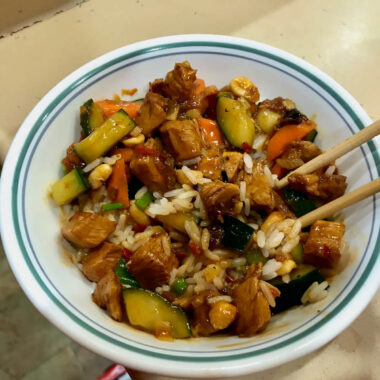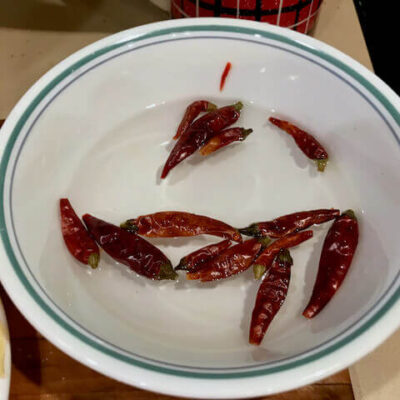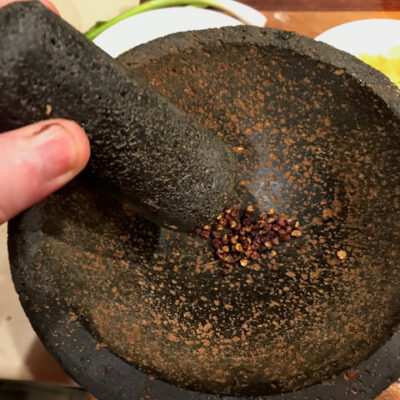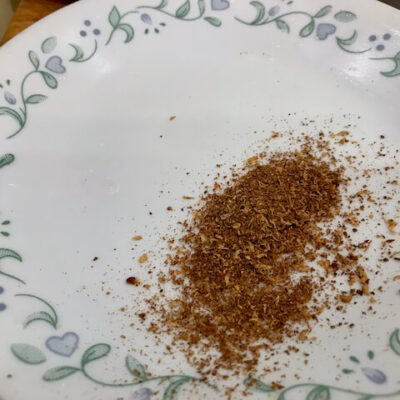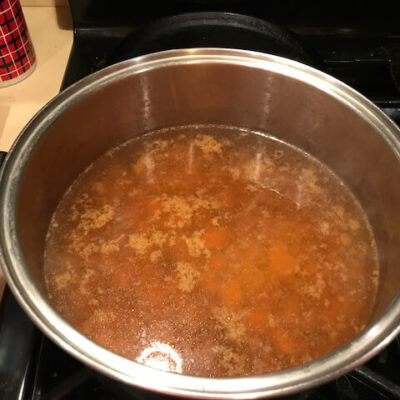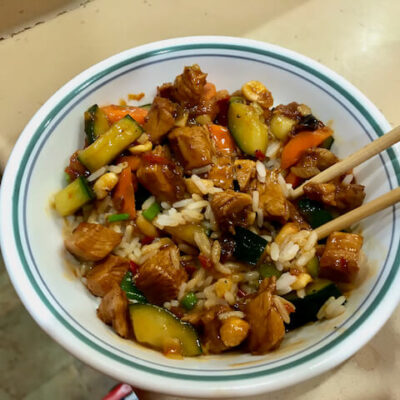American Chinese takeout food is generally not the healthiest of food. It is high in sugars, sodium, processed ingredients, and especially fats from cooking oils. Yet traditional, or authentic Chinese food, is very healthy: lots of vegetables, vitamins, and protein, but low in processed oils. I wanted to preserve the taste and texture of the restaurant version in a more economical, healthier Kung Pao chicken.

Most of the home-style recipes on My Chinese Home Kitchen use very little oil, which is both healthy and economical. Since Jing is studying to be a top-tier chef, she is learning many restaurant style dishes. Kung Pao chicken is a traditional Chinese dish, that is, it existed long before takeout restaurants offered it. Jing’s home style version is lower in fat, has no added sugar and adds vitamins from healthy garden vegetables. However, the professional style recipe is more flavorful, and the chicken is more tender because it is blanched in oil.
For this healthy Kung Pao chicken recipe, I combined the nutritional advantages of Jing’s homestyle dish with the techniques and seasoning of the professional style Kung Pao. However, I changed the way the chicken is prepared to eliminate the oil blanching. I cooked this recipe and the professional style, and had a friend compare the flavor and texture. The flavor and texture of both were identical, and this hybrid approach is less fattening and more economical to prepare.
Eating healthy on a budget
Chinese home cooking, traditionally, is very healthy. Dishes frequently contain ginger, garlic, green onions, moderate amounts of protein, balanced with healthy vegetables. It is also more economical than the professional restaurant recipes, because it uses much less oil. The vegetables extend the dish, yielding more servings from the same amount of meat while adding essential nutrients. The professional style Kung Pao chicken on My Chinese Home Kitchen will serve one or two people. However, adding vegetables easily stretches the dish to serve four.
Professor Eugene Anderson’s anthropological study, The Food of China, points out that for most Chinese, cooking with oil was rare. Oil was rare and expensive, it was mainly found in dishes prepared in restaurants for the wealthier segments of society. Also, since fuel was scarce, the Chinese became adept at feeding a family from a single pot, making maximum use of combustible materials.
I’ve been seeing a growing number of doctors, and even a presidential candidate, talking about the American diet and health. COVID brought a lot of attention to this, because obese people and diabetics were at higher risk. There’s a growing awareness that our highly processed, seed-oil laden diet may be causing the obesity and inflammation-related autoimmune diseases that have skyrocketed in the last few decades.
Unhealthy changes in the American diet
I’m not a doctor, nor do I play one on TV. I’ve seen every food alarmist claim over the years get debunked a few years later. Caffeine is bad for you. Then caffeine is good for you and may prevent Alzheimer’s. Etc. That’s the normal process of science: someone makes a hypothesis, others try to disprove the hypothesis, and new understanding emerges. However, one thing is true: when I was a kid in the 1970s, everybody was skinny. Go watch the early beach scenes in the movie Jaws (1975), and you’ll see what I mean. Then, in the 1980s and 1990s, Americans, including yours truly, began to get fat, and these diseases and allergies started to become more common. Interestingly, with the modernization in China which began a few decades ago, the same pattern is emerging there.
What changed? Well, in our family we used to eat meat, often an animal we raised (a cow or pig), or a largemouth bass we caught in the farm pond, with healthy vegetables raised in our own garden. Carrots, broccoli, lettuce, tomatoes, peas, green beans and peppers were staples. We also had cabbage, spinach, kohlrabi, radishes, cucumbers, zucchini and summer (or yellow) squash. We preserved or pickled our own vegetables. (It turns out that pickled foods are good for the gut microbiome.) Sure, TV dinners have been around since the 1950s, but we never ate them: they tasted terrible compared to real food.
In the 1980s, this began to change with microwaves and highly processed foods becoming more common. When COVID hit, Americans were eating 40% of their meals at restaurants. The nutritional criticism of processed foods emphasizes three things: empty calories from flour and emulsifiers, heavy concentration of sugar and processed oils, and chemical additives for flavor and shelf-life.
Making a healthier Kung Pao Chicken recipe
The key change was to remove the oil-based blanching. I have been reading Irene Kuo’s The Key to Chinese Cooking, and she discusses this at length. She stated she actually preferred the texture of velveted or slippery-coated chicken blanched in water. She also pointed out when preparing ingredients ahead of time, water-blanched meats could be refrigerated. Oil-blanched ingredients can not, because the oil hardens in the cold.
The other change was to include the carrots and cucumbers from Jing’s home recipe. However, I did not want to blanch these in boiling water, because that will leech the nutrients and flavor from the vegetables.
Adding vegetables
The solution was to bring boil a pot of water, blanch the chicken until it changed color, then remove it. Then cover the boiling pot with a bamboo steamer containing the vegetables. I steamed these for about two minutes, keeping an eye on the texture of the cucumber. I didn’t want mushy vegetables. They need to be crispy. I just wanted to bring out the color, and pre-cook them a bit before adding to the stir-fry.

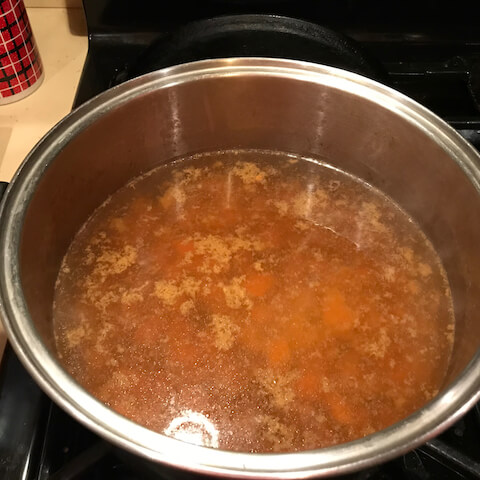
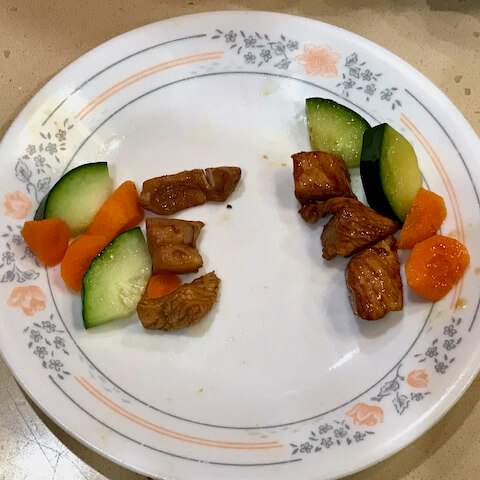
This image shows the water blanched chicken and steamed vegetables on the left. The oil-blanched chicken and vegetables are on the right. Even though I thoroughly drained the ingredients, note the oily sheen on the items on the right.
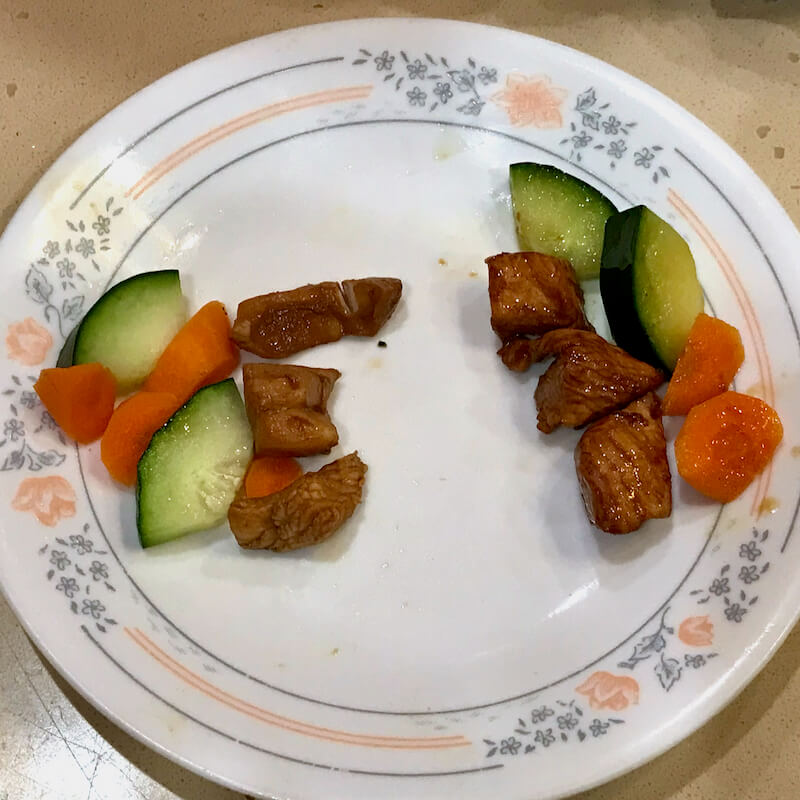
In my opinion, the carrots and cucumbers were lighter and sweeter when blanched with steam.
The preparation time for both methods is equivalent. Another advantage of the water-based approach was not having to drain hot oil from the wok.
The disadvantage of the water-based approach was the chicken lost a little flavor. I compensated by adding an extra teaspoon (5 ml) of light soy sauce to the sauce in the wok. The end result was identical.
Other changes
I did two other things. These are both optional, as they add extra preparation time, but I like the results.
Since I cannot get fresh Chinese chilies, I like to soften the dried chili peppers before cooking. So, I place them in a bowl with some hot water, and let them soak while I prepare the other ingredients.

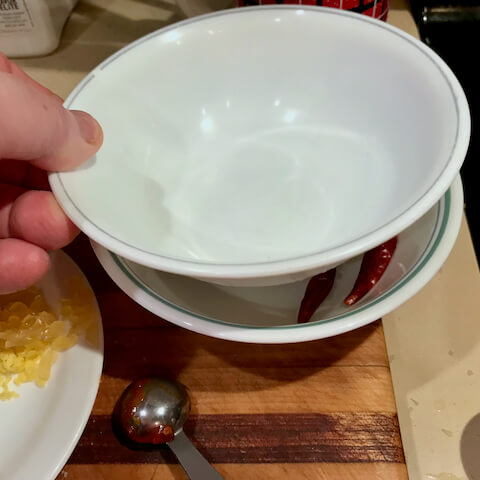
I also prefer the flavor and texture of roasted and ground Sichuan peppercorns. So, I toasted them slightly on a skillet and then ground them to a powder before adding to the stir-fry. This is also optional, and a matter of personal preference.
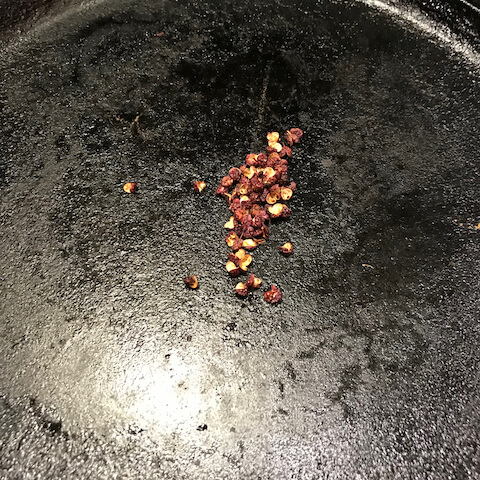

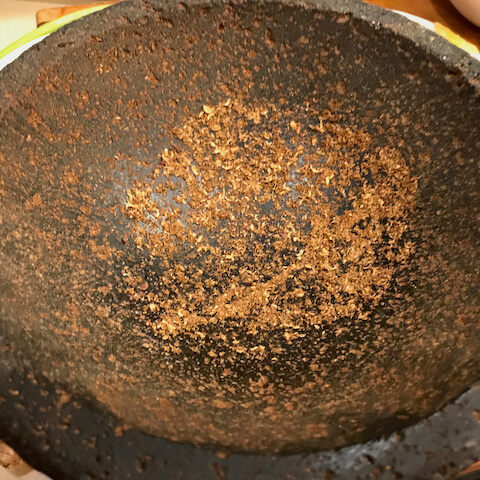
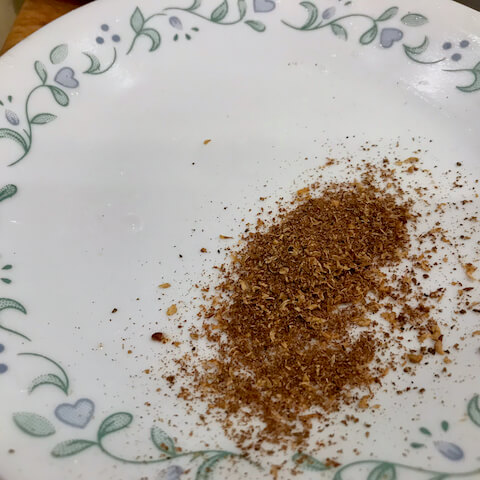
Summary
The savings from not oil-blanching is significant. A gallon of peanut oil currently sells for around $20. Adding enough to the wok to blanch the chicken and vegetables costs about $5 to $7.
I cook and test our recipes, except the few for which I cannot find ingredients. When we started the site, Jing was providing home recipes from her own kitchen and those she learned from family. Many of these are my favorite recipes. They are simple and fast to cook, they are economical, and they taste good. Until I met Jing, I’d never heard of cumin squid tentacles, or dry pot braised shrimp, or pork belly with green chilies. These are now some of my favorite meals.
When Jing started attending culinary school, she got permission to share those recipes here. Usually, her teacher gives the class a general list of ingredients, and challenges the students to determine the proportions of ingredients. So, these recipes do have her touch. The schedule demands of school make it difficult for her to develop many of her own recipes. Thus, my recipe testing started to include a lot more restaurant style dishes, and my weight increased a bit. I was not eating more quantity, so I knew it had to be the food itself.
I am hopeful that developing healthier ways to cook the delicious professional recipes will reduce my food budget and weight. Besides, cooking with oil requires more frequent cleaning of the kitchen–it gets everywhere, even on the ceiling fan.
I hope you enjoy this healthier Kung Pao chicken recipe. Please leave a comment, let us know what other articles you’d like to see.
Healthier Kung Pao Chicken, Professional Style
Equipment
- 1 wok
- 1 heat safe container for hot oil
- 1 spatula
Ingredients
- 1 chicken breast (1 lb or 500 g)
- 2 medium carrots
- 1 cucumber
Auxiliary ingredients:
- 2 scallions
- 6 slices fresh ginger
- 3 cloves garlic
- ⅓ cup dry roasted peanuts (unsalted and unsweetened)
- 5 xiao mi la (millet) chili peppers
- 10 Sichuan peppercorns (roasted and ground)
- 1 tbsp caiziyou (roasted rapeseed oil) (or peanut oil)
Chicken marinade
- 1 tsp sugar, white (granulated)
- 1 tsp dark soy sauce
- 1 tsp corn starch
- 1 tsp water
Seasonings in pan (adjust to taste)
- ½ tbsp sugar, white (granulated)
- 1 tsp Shaoxing wine (substitute white cooking wine)
- 2 tsp Pixian Doubanjiang bean paste
- 1 er jing tiao pepper, pickled
- 1 tsp Baoning vinegar (substitute white vinegar)
- 2 tsp light soy sauce
- starch water 1:1 starch and water
- 4 oz water enough to cover bottom of pan
Instructions
Preparation:
- Place the dried peppers in a small bowl and cover with hot water to soften.5 xiao mi la (millet) chili peppers
- Place a clean skillet on a burner over medium flame. Place the Sichuan peppercorns on the skill to toast them, stirring occasionally. Continue preparing the other ingredients while the peppercorns are toasting.10 Sichuan peppercorns
- When the peppercorns are darkened slightly (not burned), and just beginning to smoke, turn off the heat and transfer the peppercorns to a mortar and grind them to a powder.
- Place the ground peppercorn powder on a plate.
- Wash the chicken breast and green onions. Peel and wash the ginger, carrots and garlic. Wash the cucumber but do not peel.
- Dice the chicken into cubes.
- Place the chicken in a bowl. Add some sugar, dark soy sauce, and water and stir well. Then add starch and stir well to mix. Set aside.1 tsp sugar, white (granulated), 1 tsp dark soy sauce, 1 tsp corn starch, 1 tsp water
- Chop the green onion, ginger and garlic. Remove the skin of the peanuts. Chop the pickled peppers and bean paste together.1 er jing tiao pepper, pickled, 2 tsp Pixian Doubanjiang bean paste
- Dice or roll-cut the carrots. Cut the cucumber lengthwise into quarters, then, holding each quarter vertically, slice downward with your kitchen knife to cut away the seeds from the flesh of the cucumber. Then chop the cucumbers into pieces about the thickness of two chopsticks.
- Mix together the water, vinegar, light soy sauce and sugar. Whisk vigorously to dissolve the sugar.½ tbsp sugar, white (granulated), 2 tsp light soy sauce, 4 oz water, 1 tsp Baoning vinegar
- Remove the xiao mi la peppers from the soaking water, chop them (see note below), and place on the plate with the powdered Sichuan peppercorn.5 xiao mi la (millet) chili peppers
Cooking:
- Add enough water to a large saucepan to cover the chicken, and bring to a boil.1 chicken breast
- Blanch the chicken in the water until it changes color, then remove the chicken.
- Put a bamboo steamer over the saucepan. Add the chopped carrots and cucumbers. Cover and steam the vegetables to blanch, about 2 minutes. The vegetables should still be crispy.2 medium carrots, 1 cucumber
- Place the vegetables on the plate with the chicken cubes.
- Heat the wok until a droplet of water evaporates in 2 seconds. Add about a tablespoon (15 ml) cooking oil to the wok, then add the Sichuan peppercorns and chopped chili peppers. Stir-fry the peppers quickly until you smell the aroma and they are slightly darkened, about 15 to 30 seconds. Keep stirring and tossing so they do not scorch.5 xiao mi la (millet) chili peppers, 10 Sichuan peppercorns, 1 tbsp caiziyou (roasted rapeseed oil)
- Next, add the ginger, garlic, Doubanjiang bean paste and pickled pepper mixture, and cooking wine. Stir-fry evenly until fragrant, about 30 seconds. Keep the ingredients tossing constantly so they do not burn. Whisk the water and seasoning mixture to stir up any sugar that has settled, then add the mixture to the wok. Stir quickly to combine, until the water just starts to boil.6 slices fresh ginger, 3 cloves garlic, ⅓ cup dry roasted peanuts, 1 tsp Shaoxing wine, 2 tsp Pixian Doubanjiang bean paste, 1 er jing tiao pepper, pickled, 1 tsp Baoning vinegar, 2 tsp light soy sauce, 4 oz water, ½ tbsp sugar, white (granulated)
- Add the diced chicken and vegetables, stir fry until the broth returns to a boil, then glaze (Daqian) with starch water. Add a little bit of starch water at a time while stirring constantly to combine until the broth is thickened just enough to evenly coat the ingredients. Finally, add a small amount of oil to brighten.starch water
- Turn off the flame. Add the peanuts and green onions.⅓ cup dry roasted peanuts, 2 scallions
- Off heat, stir to combine the peanuts and scallions with the chicken and vegetables, then transfer to a serving dish.
Notes
- Adjust the amount of seasonings according to the amount of your ingredients. The taste of this dish should be savory and slightly sweet and sour.
- When blanching the chicken, turn the chicken when the color changes slightly to avoid the chicken pieces from sticking together.
- Pickled peppers and Doubanjiang bean paste are both salty, so please be sure to test the taste of this dish during the cooking process.
- Chopping the chili peppers will give the dish a hotter spice. Leave the peppers intact if you prefer a more mild dish.
- Soaking the chili peppers, and roasting the Sichuan peppercorns, are both optional.
Nutrition
Do you enjoy My Chinese Home Kitchen?
We enjoy sharing these authentic home recipes with you. My Chinese Home Kitchen is a labor of love.
Please tell your friends about us!
Learn more about My Chinese Home Kitchen at our About page.
Please leave a comment, or SUBSCRIBE to our newsletter.
For more of our original videos, visit My Chinese Home Kitchen on YouTube and Rumble.


